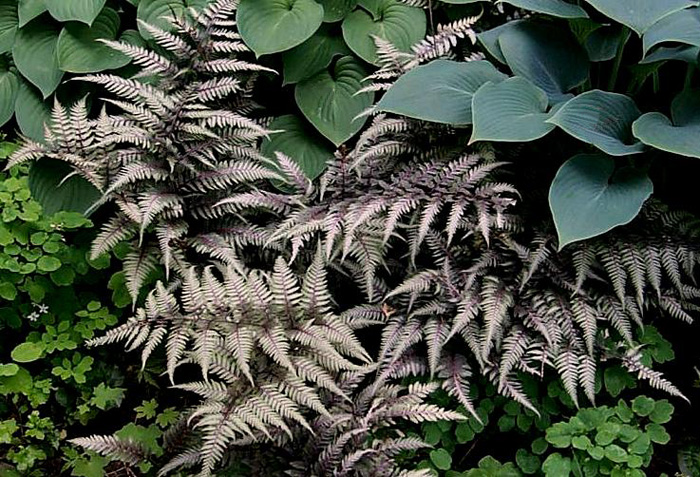Japanese Painted Fern: Graceful Foliage Delight
Introduction: The Allure of Japanese Painted Fern
Japanese painted fern, scientifically known as Athyrium niponicum var. pictum, is a captivating plant celebrated for its elegant foliage and remarkable adaptability. Originating from Japan, this fern has garnered widespread admiration among gardeners and plant enthusiasts worldwide for its unique coloration and graceful appearance.
Origins and Cultivation: From Japan to Global Gardens
Hailing from the shady woodlands of Japan, the Japanese painted fern has found its way into gardens and landscapes across the globe. Its popularity stems from its ability to thrive in a variety of environments, from moist woodland settings to shaded urban gardens. Gardeners appreciate its low maintenance requirements and its capacity to add a touch of sophistication to any green space.
Distinctive Features: A Closer Look at Its Foliage
What sets the Japanese painted fern apart is its exquisite foliage. Delicate fronds, adorned with shades of silver, purple, and green, create a mesmerizing tapestry of colors. The intricate patterns on each leaf add depth and texture to the plant, making it a standout feature in any garden bed or container. Whether planted as a solitary specimen or massed together for dramatic effect, this fern never fails to command attention.
Ideal Growing Conditions: Meeting Its Needs
Creating the perfect environment for Japanese painted ferns involves understanding their preferred growing conditions. These ferns thrive in partially shaded areas with well-draining soil that retains moisture. While they can tolerate periods of drought, consistent watering is crucial, especially during hot summer months. Mulching around the base of the plant helps retain soil moisture and suppresses weed growth, promoting healthy growth and vibrant foliage.
Landscaping with Japanese Painted Ferns: Versatile and Adaptable
The versatility of Japanese painted ferns makes them invaluable additions to landscape designs. Whether used as ground cover beneath towering trees or nestled among rocks in a shaded corner, these ferns add a touch of understated elegance to any setting. Their compact size makes them suitable for small gardens or containers, where they can be combined with other shade-loving plants to create striking compositions.
Seasonal Care and Maintenance: Keeping Them Thriving
Like any plant, Japanese painted ferns benefit from regular care and maintenance to ensure their health and vitality. During the growing season, it’s essential to monitor soil moisture levels and water as needed, especially during dry spells. Applying a balanced fertilizer in spring helps promote lush foliage growth. Removing dead or damaged fronds not only enhances the plant’s appearance but also encourages new growth.
Companion Plants: Pairing With Complementary Species
When designing with Japanese painted ferns, consider pairing them with plants that complement their color and texture. Shade-loving companions such as hostas, astilbes, and heucheras provide contrast and harmony, creating visually appealing garden vignettes. Variegated foliage and subtle blooms enhance the beauty of the ferns without overshadowing their unique charm.
Pests and Diseases: Keeping Them at Bay
While Japanese painted ferns are relatively resistant to pests and diseases, occasional issues may arise. Slugs and snails are common nuisances, especially in damp conditions, and can be controlled using organic methods or commercial slug deterrents. Proper air circulation and avoiding overhead watering help prevent fungal diseases such as leaf spot and rust, ensuring the continued health of the plants.
Propagation Techniques: Multiplying Your Collection
Expanding your collection of Japanese painted ferns is easy with propagation techniques such as division and spore sowing. Dividing mature plants in early spring allows you to create new specimens while rejuvenating established clumps. Alternatively, collecting and sowing spores from mature fronds can yield a new generation of ferns, although patience is required as this method takes longer to produce mature plants.
Cultivar Selection: Exploring Varieties and Hybrids
With a wide range of cultivars and hybrids available, choosing the right Japanese painted fern for your garden can be a delightful endeavor. From the classic ‘Pictum’ with its silver and burgundy hues to the compact ‘Burgundy Lace’ with its striking red stems, there’s a variety to suit every taste and preference. Experimenting with different cultivars adds diversity and visual interest to garden displays.
Embracing the Beauty of Japanese Painted Ferns
In conclusion, Japanese painted ferns epitomize understated beauty and grace in the world of ornamental foliage plants. Their exquisite coloration, versatile nature, and ease of cultivation make them a favorite among gardeners seeking to enhance shady corners and woodland landscapes. Whether used as focal points or subtle accents, these ferns never fail to leave a lasting impression, enriching outdoor spaces with their timeless elegance.










